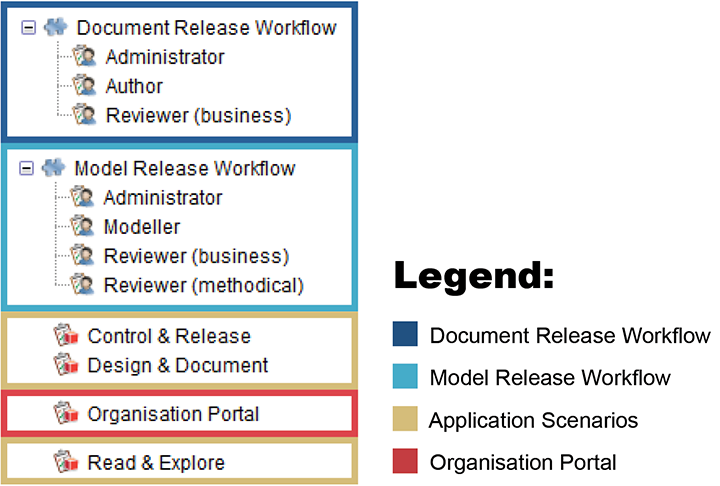After the Installation
The following shortcuts will show up on the start menu entry of ADONIS 12.0 (after a complete installation):
Manuals
The ADONIS user documentation in English and German.
Administration Toolkit
Used by a ADONIS-Administrator for example to create users or assign rights among other tasks.
Create a new database
A tool used to create new ADONIS databases.
Now you should proceed with the following steps:
Create Database
After the installation of ADONIS, a database has to be created (see "Create Database").
Import Sample Users
Are you using the ADONIS BPMS Application Library? Then import the sample users in the Administration Toolkit now. The sample users contain the default user groups and the default system roles. This configuration will allow your users to access the different application scenarios of ADONIS as well as the Organisation Portal and the release workflows that are included in ADONIS:.
Start the Administration Toolkit with the default user "Admin" (password: "password") and the name of the previously installed ADONIS 12.0 database.
Import the sample users into the ADONIS database (User Management - Import users). The respective file "<time stamp> - Sample Users with Rights.axr" can be found in the folder “04 Sample Data/Users“ on the installation medium. When importing the sample users you have to activate the following options:
Recursive
Including system roles
Including metamodel rights
Assign current repository automatically
Create a user in the Administration Toolkit for every person who wants to work with ADONIS (User Management - Create user).
Add the users to the appropriate user groups and system roles depending on their tasks in ADONIS. The sample users can serve as a template for this.
You can import the ADONIS Standard Migration Package instead of the sample users. This package contains an extended set of users and example models. The example models serve to illustrate the modelling of business processes and working environments with ADONIS. The respective file can be found in the folder “04 Sample Data/Migration Package“ on the installation medium.
Default User Groups
The following user groups comprise the default user groups:
Designer
Members of the user group "Designer" will have write access to the standard model group and the standard object group. For users who model in ADONIS.
Reader
Members of the user group "Reader" will only have read access to the standard model group and the standard object group. For users who read processes or review and release processes in ADONIS. Typically this user group will also hold a technical user account. This user account is used when users access the Organisation Portal via the link on the web client login page.
Default group
Typically this user group will only hold technical user accounts. These user accounts are used when synchronizing objects between ADONIS and another BOC Management Office product and in other special scenarios.
Default System Roles
The following system roles comprise the default system roles:

Document Release Workflow
Author
Authors create and submit documents to review. They can also create new versions of already released documents in order to adapt them.
Reviewer (business)
Reviewers perform business reviews of the submitted documents and release them.
Administator
Administrators can execute all transitions. They are responsible for the maintenance of the release process. Only Administrators can archive documents.
Model Release Workflow
Modeller
Modellers create and submit models to review. They can also create new versions of models which have already been released in order to adapt them.
Reviewer (business, methodical)
Reviewers perform methodical reviews and business reviews of the submitted models.
Administator
Administrators can execute all transitions. They are responsible for the maintenance of the release process. Only Administrators can archive models.
Application Scenarios
Read & Explore
Members of the system role "Read & Explore" will have access to the "Read & Explore" scenario. The purpose of the "Read & Explore" scenario is to let users read processes, explore working instructions and process handbooks.
Design & Document
Members of the system role "Design & Document" will have access to the "Design & Document" scenario. Via the "Design & Document" scenario they will be able to model and create transparency in a structured way.
Control & Release
Members of the system role "Control & Release" will have access to the "Control & Release" scenario. The purpose of the "Control & Release" scenario is to let users review and release processes with a single click.
Organisation Portal
Organisation Portal
Typically only one technical user account will have this system role. This user account is used when users access the Organisation Portal via the link on the web client login page.
Install Web Client
In order to host ADONIS as a web application, the web client has to be installed and configured next (see "Install Web Client").